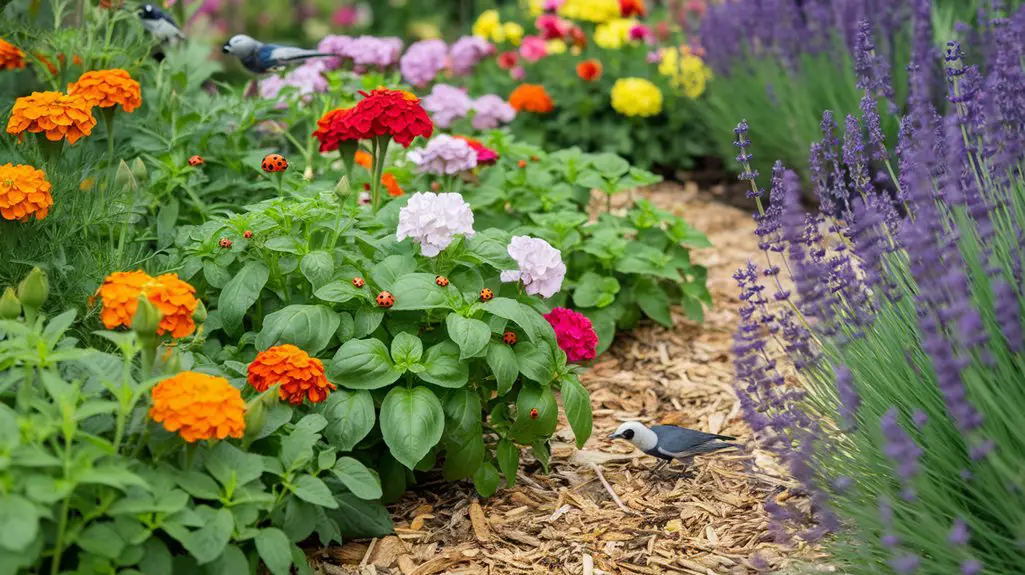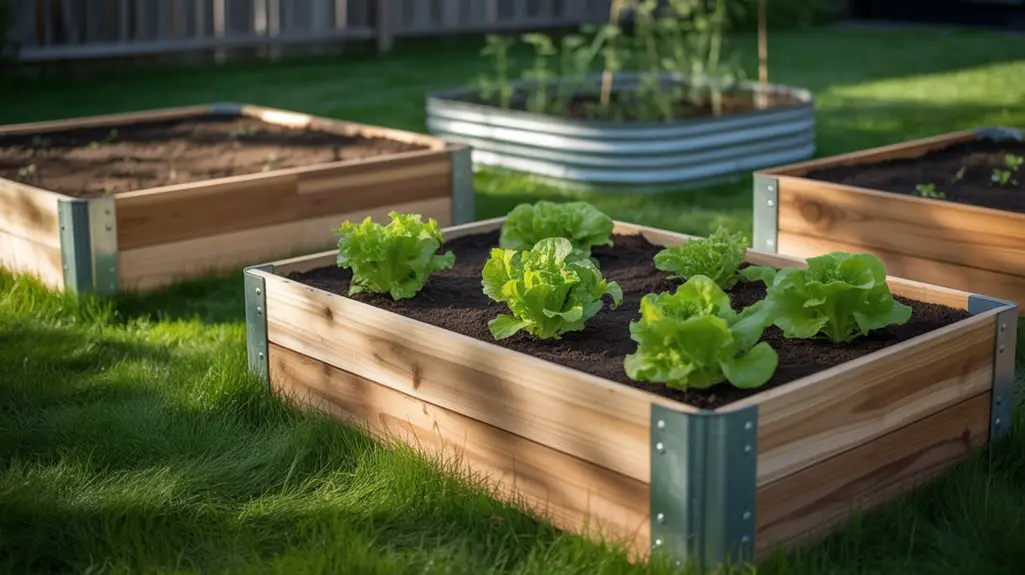Imagine stepping into your garden at dawn to find perfectly formed leaves instead of the tattered remnants left by hungry pests. You don’t need harsh chemicals to protect your plants from unwanted visitors. Natural pest management works with your garden’s ecosystem rather than against it. By combining companion planting, organic sprays, beneficial predators, and strategic barriers, you’ll create a balanced environment where your plants can thrive while deterring the most persistent garden invaders.
Companion Planting Strategies for Pest Management
While many gardeners resort to chemical pesticides, companion planting offers a natural alternative that has been practiced for centuries. This method strategically positions plants to deter pests, attract beneficial insects, or improve growth.
Plant aromatic herbs like basil near tomatoes to repel hornworms, or marigolds throughout your garden to ward off nematodes. Nasturtiums serve as trap crops, drawing aphids away from your vegetables. Interplant garlic or chives among roses to prevent black spot and aphids.
You’ll find that strong-scented plants like mint and rosemary naturally repel cabbage moths and carrot flies. Additionally, using companion planting techniques can enhance the overall health of your garden by creating a balanced ecosystem.
Remember to take into account each plant’s growing requirements when planning your companion strategy—compatible water needs and sunlight preferences guarantee both plants thrive while protecting each other.
Homemade Organic Sprays and Deterrents

Beyond companion planting, creating your own organic sprays offers another powerful tool in your natural pest management arsenal.
These homemade solutions are cost-effective and free from harmful chemicals.
A simple garlic spray (crush 5 cloves in 2 cups water, strain after 24 hours) repels aphids, cabbage loopers, and whiteflies.
For fungal issues, mix 1 tablespoon baking soda with 1 gallon water and a drop of dish soap.
To deter slugs, spray a coffee solution (1 part strong coffee to 5 parts water) directly on plants.
Oil sprays suffocate soft-bodied insects—combine 1 cup vegetable oil with 1 tablespoon mild soap, then mix 2 teaspoons of this concentrate with 1 cup water before application.
Always test sprays on a small plant area first to prevent leaf damage. Additionally, using eco-friendly pest control solutions can enhance the effectiveness of these sprays and further protect your garden.
Creating Habitats for Beneficial Predators

As you develop your organic garden strategy, inviting natural predators becomes an essential cornerstone of effective pest management. Birds, ladybugs, praying mantises, lacewings, and predatory wasps all help control pest populations naturally.
Create bird-friendly spaces with birdhouses, birdbaths, and native trees. Plant flowering herbs like dill, fennel, and yarrow to attract beneficial insects with their nectar and pollen.
Leave some areas of your garden slightly wild—undisturbed leaf litter and small brush piles provide shelter for ground beetles and spiders.
Consider installing a small pond to invite frogs and toads, which consume slugs and insects. Avoid broad-spectrum insecticides that kill beneficial predators alongside pests. Additionally, providing habitats for beneficial insects can significantly enhance their presence in your garden.
Instead, use targeted treatments only when necessary. With patience, you’ll establish a balanced ecosystem where nature does much of your pest control work.
Physical Barriers and Traps for Common Garden Pests
Physical barriers and traps represent another layer of defense in your organic pest management toolkit. By creating simple obstacles, you’ll prevent pests from reaching your precious plants in the first place. Surround seedlings with copper tape to repel slugs and snails, or install floating row covers to block flying insects while allowing sunlight and water through.
For larger pests, consider raised beds with hardware cloth underneath to deter burrowing animals. Sticky traps work wonders for aphids and whiteflies, while beer traps effectively collect slugs overnight. Diatomaceous earth sprinkled around plants creates a microscopic barrier that slices through soft-bodied insects’ exoskeletons when they attempt to cross. Chemical-free pest solutions are not only effective but also safe for beneficial insects and the environment.
Remember to check and maintain your barriers regularly, especially after rain, to guarantee continuous protection throughout the growing season.
Soil Health Practices That Naturally Repel Pests
The foundation of a pest-resistant garden lies in building healthy soil that naturally deters unwanted visitors. Start by maintaining proper pH levels (6.0-7.0) through regular soil testing.
Add compost to introduce beneficial microorganisms that help plants develop natural pest resistance.
Implement crop rotation to disrupt pest life cycles and prevent pathogen buildup in your soil. Consider adding biochar, which improves soil structure while creating habitat for beneficial insects that prey on pests.
Don’t forget to mulch consistently—it prevents soil compaction and moderates temperature fluctuations that can stress plants. Stressed plants emit chemical signals that attract pests.
Finally, incorporate cover crops like mustard and marigolds that release natural compounds toxic to soil-borne pathogens and nematodes. Additionally, practicing integrated pest management can enhance your garden’s resilience against pest invasions.
Aromatic Herbs and Plants That Deter Unwanted Insects
Many aromatic plants serve double-duty in your garden, providing culinary benefits while naturally repelling pests through their strong scents and essential oils.
Lavender repels moths, fleas, and mosquitoes while attracting pollinators. Plant basil near tomatoes to deter thrips and flies. Rosemary’s woody scent confuses carrot flies, cabbage moths, and bean beetles.
Marigolds release thiopene, a compound that repels nematodes when planted throughout your garden. Mint deters ants, aphids, and cabbage moths, but plant it in containers as it spreads aggressively.
Chives repel Japanese beetles and carrot rust flies—place them strategically near susceptible plants. Garlic and nasturtiums offer protection against aphids. Additionally, incorporating these plants can enhance organic pest control by creating a diverse ecosystem that naturally balances pest populations.
For maximum effectiveness, distribute these aromatic plants throughout your garden rather than isolating them in a separate herb section.
Timing and Rotation Techniques to Minimize Pest Infestations
Strategic timing of your plantings can greatly disrupt pest life cycles and reduce infestations without chemical interventions. By understanding when pests emerge and rotating crop families, you’ll create an environment where creatures can’t establish persistent populations. Implementing effective natural pest control methods will further enhance your garden’s resilience to pests.
| Crop Family | Rotation Wait | Common Pests | Best Planting Time | Companion Plants |
|---|---|---|---|---|
| Solanaceae | 3-4 years | Tomato hornworm | After last frost | Basil, marigolds |
| Brassicas | 2-3 years | Cabbage moths | Early spring/fall | Thyme, rosemary |
| Cucurbits | 2 years | Cucumber beetles | When soil warms | Nasturtiums |
| Legumes | 1-2 years | Aphids | Mid-spring | Garlic, onions |
| Alliums | 3 years | Onion maggots | Early spring | Carrots, beets |
Don’t plant the same family in sequence—this breaks pest cycles and preserves soil nutrients simultaneously.
Conclusion
By implementing these natural pest control methods, you’re not just protecting your garden—you’re creating a thriving ecosystem. Whether you’re planting aromatic companions, crafting homemade deterrents, or welcoming beneficial predators, each strategy builds upon the next. Remember, through patience and persistence, you’ll transform your garden from a pest’s paradise into nature’s perfect balance. After all, your garden’s health reflects your harmonious approach to working with nature, not against it.




